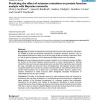Free Online Productivity Tools
i2Speak
i2Symbol
i2OCR
iTex2Img
iWeb2Print
iWeb2Shot
i2Type
iPdf2Split
iPdf2Merge
i2Bopomofo
i2Arabic
i2Style
i2Image
i2PDF
iLatex2Rtf
Sci2ools
BMCBI
2006
2006
Predicting the effect of missense mutations on protein function: analysis with Bayesian networks
Background: A number of methods that use both protein structural and evolutionary information are available to predict the functional consequences of missense mutations. However, many of these methods break down if either one of the two types of data are missing. Furthermore, there is a lack of rigorous assessment of how important the different factors are to prediction. Results: Here we use Bayesian networks to predict whether or not a missense mutation will affect the function of the protein. Bayesian networks provide a concise representation for inferring models from data, and are known to generalise well to new data. More importantly, they can handle the noisy, incomplete and uncertain nature of biological data. Our Bayesian network achieved comparable performance with previous machine learning methods. The predictive performance of learned model structures was no better than a na
| Added | 10 Dec 2010 |
| Updated | 10 Dec 2010 |
| Type | Journal |
| Year | 2006 |
| Where | BMCBI |
| Authors | Chris J. Needham, James R. Bradford, Andrew J. Bulpitt, Matthew A. Care, David R. Westhead |
Comments (0)

